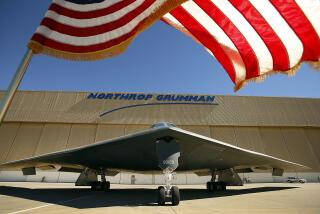Northrop to Boost Hiring at Palmdale : Appears Closer to Production of Secret Stealth Bomber
- Share via
Northrop will begin hiring and transferring employees in early 1986 to a new Palmdale factory that is believed to be the future production site of the Stealth bomber, marking a significant step forward in the secret aircraft program.
Northrop spokesman Tony Cantafio said Monday that the Los Angeles-based firm expects to have 400 to 600 employees at the Palmdale plant by mid-1986 and 1,000 to 1,500 employees by mid-1987. The hiring appears to confirm recent estimates that Northrop could begin Stealth bomber production within several years.
The staffing of the Palmdale plant was approved by the Air Force, according to Col. R. Douglas McLarty, director of public affairs at Wright-Patterson Air Force Base, where the Stealth program is managed.
Although McLarty said he could not provide other details about the approval, defense experts said Monday that it signifies that Northrop has reached a major turning point in the Stealth program.
Precursor to Production
“It certainly means not less than the fact that they expect to cross a milestone in the near future, if they haven’t already crossed it,” said James B. Stewart, a retired Air Force general who commanded Wright-Patterson. “It could be a go-ahead to build two or three or four development articles, which could be a precursor to production.”
Military programs must pass numerous “milestones,” such as the transition from research to advanced development. Each milestone requires approval from high-level committees of military and senior Pentagon officials.
Northrop was selected by the Air Force as prime contractor for the advanced technology bomber, better known as the Stealth, in October, 1981, but the Pentagon has made few disclosures about the important program since then. The Stealth bomber is being designed to be nearly invisible to enemy radar and infrared detectors. The Palmdale plant will be operated by Northrop’s advanced systems division, “which currently manages numerous aerospace projects, including Northrop’s work on the advanced technology bomber,” Cantafio said.
Northrop will transfer current employees for most of the initial staffing at the plant, Cantafio said, but later staffing will be filled by outside hiring. Cantafio said he could not disclose how many of the 1,000 to 1,500 workers expected at the plant by mid-1987 would be new hires.
Although Northrop has never disclosed the expected peak of the Stealth work force, analysts say it could easily exceed 10,000. The B-1B bomber program at Rockwell International, now in production, employs about 15,000.
Northrop began construction of the Palmdale plant in May, 1984. The facility, which is closed to the public, is a massive 250-acre complex of office buildings, a large assembly hangar and related manufacturing buildings.
The plant is owned by the Air Force, McLarty said. It is located at Air Force Plant 42, a nine-square-mile complex of government-owned production plants, hangars and runways where some of the nation’s most advanced aircraft have been assembled, including the space shuttle and various secret spy planes.
Pico Rivera Hirings
In addition to the Palmdale plant, Northrop is adding significant numbers of new employees at its Pico Rivera plant, which is also engaged in Stealth bomber work. Cantafio said the plant now employs 8,000, up sharply from the 6,000 reported last year.
Northrop Chairman Thomas V. Jones said earlier this year at the Northrop annual shareholders meeting that the firm expects to hire 4,500 new workers in the remainder of 1985, certainly the most ambitious hiring program in the aerospace industry.
Northrop has also been feverishly adding space at the Pico Rivera site, completing 700,000 square feet of new construction in the past two years, and is in the process of adding several new buildings, according to Pico Rivera city officials.
Another measure of Northrop’s increased Stealth activity is the sharp rise in the firm’s sales. Northrop aircraft sales shot up 53% in the first nine months of 1985, largely due to unidentified work that Wall Street analysts say is the Stealth program.
McLarty said the Stealth program is headed by Col. Richard M. Scofield, deputy for the advanced technology bomber.
The fact that the Stealth program is headed by a colonel would also indicate that it is still years away from production. The B-1 production program, which has a much higher level of funding than the Stealth, has been headed by generals.
More to Read
Inside the business of entertainment
The Wide Shot brings you news, analysis and insights on everything from streaming wars to production — and what it all means for the future.
You may occasionally receive promotional content from the Los Angeles Times.











